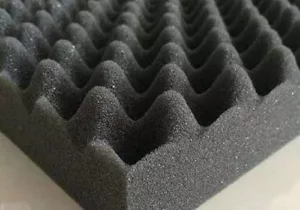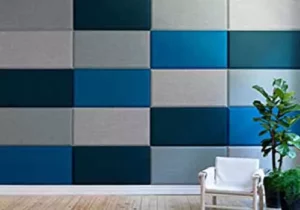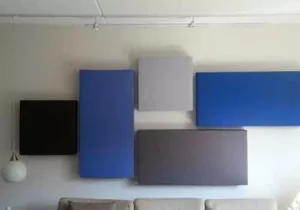Acoustic Insulation for Vibration Control
Introduction
Welcome to our article on the topic of Acoustic Insulation for Vibration Control. In this piece, we will delve into the fascinating world of using special materials to manage both sound and vibrations. You might be wondering how Acoustic Insulation for Vibration Control works, and why it’s gaining attention in various fields. Well, you’re in the right place to find out! We’ll explore the concept behind this technology and its practical applications in different areas. So, if you’re curious about how to make spaces quieter and more comfortable while also preventing disruptive vibrations, keep reading to discover the power of Acoustic Insulation for Vibration Control.
What is Acoustic Insulation?


Acoustic insulation refers to the use of materials and techniques that minimize the transmission of sound and vibrations between spaces. It involves creating barriers to prevent noise from entering or escaping an area, resulting in improved sound quality and reduced disturbances. Acoustic Insulation for Vibration control is majorly carried out during the installation of False ceiling and Drywall Partitions. The insulation material is inserted or sandwiched between the boards and within the framework.
The Importance of Acoustic Insulation for Vibration Control
Unwanted vibrations can lead to a host of issues, ranging from compromised sound quality to structural damage. In recording studios, vibrations can interfere with audio recordings, affecting the final product’s clarity and fidelity. In industrial settings, vibrations can cause equipment malfunction and impact worker productivity. Acoustic insulation plays a vital role in managing such issues and enhancing the overall experience and efficiency.
Types of Acoustic Insulation for Vibration Control
Several effective materials are used for acoustic insulation. Let’s explore some popular options:
- Mass-Loaded Vinyl (MLV):
Mass-loaded vinyl is a dense and flexible material used to block sound and reduce vibrations. It’s an effective solution for home theaters, sound studios and Residential spaces. - Acoustic Foam Panels
Acoustic foam panels are lightweight and porous, designed to absorb sound waves and minimize echoes. They are commonly used in recording studios and home theaters. They are available in a variety of thicknesses and design. The higher the thickness of the panel, the better the Acoustic Insulation properties. - Insulation Rolls / Slabs
Fiberglass insulation, Mineral Rock wool Insulation and Poly wool are among the most versatile options for Insulation. They not only help in Acoustic Acoustic but also provide very good heat and thermal insulation. It effectively reduces noise and is suitable for both Dry wall Partitions and False ceiling. - Green Glue Compound
Green Glue is a viscoelastic compound used between layers of drywall to dampen sound vibrations. It’s an ideal choice for soundproofing walls and floors. - Soundproof Curtains
Soundproof curtains are an easy-to-install solution for reducing noise and vibrations. They are commonly used in residential and commercial settings. The thicker the curtain, better the insulation.
Factors to Consider When Choosing Acoustic Insulation for Vibration Control
Selecting the right acoustic insulation requires careful consideration of various factors:
- Noise Reduction Coefficient (NRC):
The NRC rating indicates how well a material absorbs sound. Choosing insulation with a higher NRC rating ensures better noise reduction. For example, if a Acoustic material states that it has a N.R.C Value of 0.90 at 1000 Hz, it means that the Acoustic Material can absorb 90% of the Sound at 1000 Hz on impact. So, higher the NRC value, higher the absorption rate. However, the NRC value will be inconsistent at different Hz. So, make sure to identify the Hz level that you want to treat or absorbed and then choose the material accordingly - Sound Transmission Class (STC) Rating:
STC rating measures a material’s ability to block sound. For optimal results, select insulation with a higher STC rating. - Installation:
Consider the complexity of installation and whether professional help is needed for certain materials. DIY options are good when you are on a tight budget and the installation is relatively easy. If you are looking for guaranteed results or for a Professional setup, then I would recommend you to choose a consultant. - Cost:
Balance your budget with the insulation’s performance to find the most suitable option.
Benefits of Acoustic Insulation for Vibration Control
Acoustic insulation offers various benefits, including:
- Enhanced Sound Quality:
By reducing the transmission of unwanted noise, acoustic insulation contributes to a more favorable and controlled auditory environment. This is particularly beneficial in spaces where clear communication or enjoyable sound experiences are crucial, such as recording studios, theaters, and conference rooms. - Improved Productivity:
Acoustic insulation aids in maintaining a quieter and less disruptive atmosphere in workplaces. This quieter environment can lead to increased focus, concentration, and overall productivity among employees. In industrial settings, reduced noise levels can also minimize stress and fatigue among workers. - Increased Privacy:
Acoustic insulation helps uphold privacy by preventing sound from traveling between adjacent spaces. This is indispensable in settings where confidential conversations occur, such as offices, medical facilities, and hotel rooms. By creating sound barriers, acoustic insulation ensures that sensitive information remains confidential. - Protection of Equipment and Structures:
Excessive noise can be detrimental to both equipment and structural integrity. Acoustic insulation safeguards machinery and equipment from potential damage caused by vibration and noise-related stress. Moreover, it prevents structural components from weakening due to constant exposure to high noise levels, extending the lifespan of buildings and infrastructure.
In essence, acoustic insulation serves as a valuable tool for optimizing sound environments, fostering improved working conditions, preserving privacy, and upholding the longevity of equipment and structures.
Applications of Acoustic Insulation for Vibration Control
Acoustic insulation finds applications in diverse settings, such as:
- Residential Buildings:
Acoustic insulation is applied in residential spaces to create a more peaceful and comfortable living environment. It minimizes the transmission of noise from neighboring units or external sources, enhancing the tranquility and privacy within homes. - Commercial Offices:
In office settings, acoustic treatment aids in maintaining a focused and productive atmosphere by curbing the intrusion of distracting noises. It ensures that employees can work without being disrupted by conversations, footsteps, or equipment noises from adjacent areas. - Educational Institutions:
Acoustic insulation is crucial in schools and universities, where an optimal learning environment is essential. It reduces the propagation of sound between classrooms and other spaces, facilitating effective teaching and learning by diminishing auditory disturbances. - Theatres and Auditoriums:
Acoustic insulation plays a pivotal role in theaters and auditoriums, where clear and immersive sound experiences are paramount. By controlling sound reflections and minimizing external noise infiltration, it contributes to superior acoustics, ensuring that performances and presentations are enjoyed to the fullest. - Industrial Facilities:
Industrial settings often feature high levels of noise generated by machinery, equipment, and production processes. Acoustic insulation mitigates noise pollution, safeguarding the well-being of workers and minimizing the impact of noise on nearby residential areas. It also prevents excessive noise from causing damage to equipment and affecting production efficiency.
In each of these contexts, acoustic insulation serves as a valuable tool for creating comfortable, functional, and harmonious environments by addressing the unique sound challenges presented by different spaces.
Common Misconceptions About Acoustic Insulation for Vibration Control
- Myth: Acoustic Insulation Completely Eliminates Noise.
Fact: Acoustic insulation is indeed highly effective in diminishing noise levels, but achieving absolute noise elimination is a complex feat. While it substantially reduces sound transmission, complete eradication of all sound is challenging due to various factors such as structural weaknesses and sound leaks. - Myth: Acoustic Insulation is Only Necessary for Music Studios.
Fact: Contrary to this belief, acoustic insulation offers advantages far beyond music studios. Any setting seeking noise control can benefit, from homes and offices to industrial facilities and hospitals. It’s valuable wherever sound quality, privacy, and productive environments are desired. - Myth: Acoustic Insulation is Costly and Difficult to Install.
Fact: Acoustic insulation encompasses a range of options, some of which are budget-friendly and suitable for DIY installation. While premium materials may be pricier, affordable alternatives provide effective noise reduction. Moreover, advancements in installation techniques and user-friendly materials have made the process more manageable for those without professional expertise.
Dispelling these myths clarifies the valuable role that acoustic insulation plays in creating more comfortable and functional spaces, offering solutions that cater to various needs and budget considerations.
How to Maintain Acoustic Insulation for Vibration Control
Maintaining acoustic insulation is crucial to ensure its continued effectiveness in providing a quieter and more comfortable environment. Here are some steps you can take to properly maintain acoustic insulation:
- Regular Inspection: Periodically inspect the acoustic insulation materials for any signs of damage, wear, or deterioration. Look for tears, gaps, or compression in the insulation, as these issues can compromise its performance.
- Seal Gaps and Leaks: Check for any gaps, cracks, or openings in walls, ceilings, or floors that could allow sound to bypass the insulation. Seal these gaps using appropriate materials, such as acoustic caulk or weatherstripping, to maintain the integrity of the sound barrier.
- Prevent Moisture: Moisture can reduce the effectiveness of acoustic insulation over time. Ensure that the insulation materials are not exposed to water leaks or humidity. Address any leaks promptly and consider using moisture-resistant insulation in areas prone to dampness.
- Avoid Compression: Avoid placing heavy objects or applying pressure on acoustic insulation materials, as this can compress them and reduce their ability to absorb sound. Be cautious when moving furniture or other items near insulated surfaces.
- Regular Cleaning: Keep the insulated surfaces clean to prevent dust buildup, which can affect the insulation’s performance. Dust and dirt can reduce the sound-absorbing capabilities of the materials. Use a soft brush or a vacuum with a soft brush attachment to gently clean the surfaces.
- Protect from Pests: Ensure that the insulation is protected from pests like rodents and insects, as they can damage the materials and create openings that compromise the sound barrier. Seal any potential entry points and consider using pest control measures if necessary.
- Avoid Modifications: If the acoustic insulation was professionally installed, avoid making modifications that could disrupt its effectiveness, such as drilling holes or removing sections of insulation without proper guidance.
- Regular Maintenance Schedule: Establish a regular maintenance schedule to check the condition of the acoustic insulation and address any issues promptly. This can help extend the lifespan of the materials and maintain their performance.
- Consult Professionals: If you notice significant damage or deterioration in the acoustic insulation, consider consulting professionals who specialize in insulation installation and maintenance. They can assess the situation and provide guidance on necessary repairs or replacements.
By following these maintenance steps, you can ensure that your acoustic insulation continues to provide the desired noise control benefits, contributing to a more peaceful and comfortable living or working environment.
Conclusion – Acoustic Insulation for Vibration Control
In conclusion, the application of acoustic insulation for vibration control emerges as an indispensable solution for mitigating the adverse effects of unwanted vibrations in various settings. By employing specialized materials and techniques, such as resilient mounts, sound-absorbing panels, and isolation pads, acoustic insulation for vibration control offers a comprehensive approach to reducing noise and minimizing structural reverberations.
This strategic combination of acoustic and vibration control not only enhances the auditory experience but also safeguards the structural integrity of buildings and equipment. Whether in residential, commercial, or industrial contexts, the implementation of acoustic insulation for vibration control stands as a testament to the pursuit of quieter, more harmonious environments. With its multifaceted benefits, acoustic insulation for vibration control proves to be an essential tool for promoting well-being, productivity, and the longevity of structures in the face of disruptive vibrations.
FAQs (Frequently Asked Questions) – Acoustic Insulation for Vibration Control
What is the best acoustic insulation for my home studio?
The best acoustic insulation depends on factors like your budget, the size of the studio, and the level of noise reduction required. Acoustic foam panels and mass-loaded vinyl are popular choices.
Can acoustic insulation reduce external noise?
Yes, acoustic insulation can effectively reduce external noise, creating a peaceful environment inside your space.
Is acoustic insulation suitable for industrial applications?
Absolutely! Acoustic insulation is widely used in industrial settings to control noise and vibrations from machinery and equipment.
Can I install acoustic insulation myself?
For simpler materials like acoustic foam panels, DIY installation is possible. However, for more complex solutions, professional installation is recommended.
Will acoustic insulation completely eliminate vibrations?
While acoustic insulation significantly reduces vibrations, complete elimination may not be achievable. However, it can substantially improve the overall environment by minimizing vibrations.
About the Author


Address
#6, 10th B Cross, Jayswal Center, KHB Main Road, Kaveri Nagar, Kanakanagar, RT Nagar Post, Bangalore – 560032
Mobile Number
+919008400702
+919945034989
Email Address
anil@jayswalgroup.com
sales@jayswalgroup.com